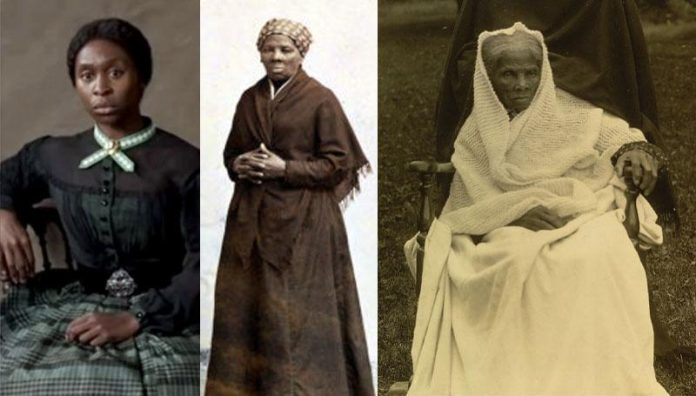Harriet Tubman (c. 1820-1913) escaped slavery and became a leader of the abolitionist movement. She led hundreds of slaves to freedom on the Underground Railroad line.
Who was Harriet Tubman?
Born a slave in Maryland, Harriet Tubman escaped to freedom in the North in 1849 and became the most famous “conductor” of the Underground Railroad. In this complex network of hiding places, Tubman risked his life to lead hundreds of family members and other slaves to freedom from the plantation system. Before the Civil War, Tubman was a prominent abolitionist and continued to work for the Union Army as a spy during the war.
After the Civil War, Tubman worked to help impoverished former slaves and the elderly; in 2016, the U.S. Treasury Department announced that Tubman would replace Andrew Jackson as the centerpiece of a new $20 bill honoring her life and public demand.

Biography and Family
Tubman’s birth year is unknown, but it was likely between 1820 and 1825; she was one of nine children born to enslaved parents in Dorchester County, Maryland, between 1808 and 1832. Mary Patterson Broad was owned by her mother, Harriet “Litt” Green. Anthony Thompson owned his father, Ben Ross (Thompson and Broadus eventually married).
Tubman was born Araminta Harriet Ross, who was nicknamed “Mindy” by her parents. Around the time of her marriage, Araminta changed her name to Harriet, possibly in honor of her mother.
Tubman’s childhood was filled with adversity. Three of Tubman’s sisters were sold to a distant farm by Mary Broad’s son Edward, and the family was cut off. When a businessman from Georgia approached Broad about buying Moses, Litt’s youngest child, Litt successfully resisted further family breakdown and set a strong example for her youngest daughter.
Tubman and her family faced daily physical attacks. As a result of the attacks she experienced at a young age, she suffered permanent physical damage. Tubman later recounted how she was slashed five times before breakfast one day. She would live with these scars for the rest of her life.
Tubman’s worst wound was sustained when she was a teenager. When he went to the dry goods store to buy supplies, he encountered a slave who had escaped from the fields without permission. Tubman’s supervisor ordered him to help restrain the runaway. When Tubman refused, the supervisor hit her over the head with a 2-pound weight. Subsequently, Tubman suffered from seizures, severe headaches and narcolepsy. She also had religious experiences, which she defined as vivid dreams.
For Tubman and his family, the line between freedom and slavery was blurred. Tabman’s father, Ben, was freed from slavery at the age of 45 under the will of his former master. Nevertheless, Ben had no choice but to continue working for his former employer as a lumber estimator and foreman.
Although Lito and his children had the same conditions of emancipation, the family owner decided not to free them. Although a free man, Ben had little power to reverse this decision.
Husband and children
In 1844, Harriet Tubman, a free black woman, married. At the time, about half of the African Americans on Maryland’s Eastern Shore were free, and it was not uncommon for a family to include both free and slave members.
Little information is available about John and Harriet’s marriage, including whether they lived together and for how long. Any children born to them would have been considered slaves, as the status of the mother would have affected the status of her children. John chose to remain in Maryland with his new wife rather than travel the Underground Railroad with Harriet.
Tubman married Civil War veteran Nelson Davis in 1869; he adopted a baby girl, Gertie, in 1874.
The Underground Railroad and Siblings
Tubman ran the Underground Railroad from the South to the North 19 times between 1850 and 1860. He led more than 300 people, including his parents and siblings, from slavery to freedom, and his accomplishments earned him the nickname “Moses.
Tubman first encountered the Underground Railroad in 1849 while trying to escape slavery. Tubman decided to flee slavery in Maryland for Philadelphia after an illness and the death of her owner. She feared for the future of her family and for her fate as a frail slave of low economic value.
On September 17, 1849, she was accompanied by her two brothers, Ben and Harry. After seeing the announcement in the Cambridge Democrat that Araminta would be rewarded $300, Harry and Ben changed their minds and returned to the plantation. Tubman had no intention of becoming a prisoner of war. After making sure her brothers were safe, she headed off alone to Pennsylvania.
Tubman walked more than 90 miles to Philadelphia via the Underground Railroad.” When I realized I had crossed that border, I glanced at my hands to see if it was the same person,” she said later, describing her relief and surprise as she entered the free state of Pennsylvania. Everything was bathed in light, the sun moved like gold through the trees and plains, and I felt like I was in heaven.
In December 1850, Tubman received word that his niece Cassia and her two children were for sale. At an auction in Baltimore, Cassia’s husband, John Pauley, a free black man, won the bid for his wife. The family then made the long trip to Philadelphia with the help of Tubman. Tubman’s trip was the first of many such journeys.
In December 1851, Tubman led eleven fugitives to Canada. As evidence, the group stopped at the home of abolitionist and former slave Frederick Douglass.
In April 1858, Tubman met abolitionist John Brown, who urged him to use violence to disrupt and abolish slavery. Brown’s ideals were shared by Tubman, who at least tolerated his methods. Before they met, Tubman said, he had a prophetic view of Brown.
When Brown began gathering followers to attack slave traders at Harper’s Ferry, he turned to “General Tubman” for help. After Brown was killed, Tubman praised Brown as a martyr.
Tubman remained active during the Civil War. Tubman began her career as a cook and nurse in the Union Army, then became an armed scout and spy. She led the Combahee River Raid that freed more than 700 slaves in South Carolina and was the first woman to lead an armed expedition in the war.
Later Years
In early 1859, abolitionist Senator William H. Seward sold Tubman a small tract of land outside of Auburn, New York. Tubman’s family and associates took refuge on a farm in Auburn. After the war ended, Tubman remained on the land for several years, caring for his family and others who had moved to the area.
Despite his fame and infamy, Tubman was never financially secure. Tubman’s supporters and friends were able to raise funds to help her. Sarah H. Bradford, an admirer of Tubman, wrote a book entitled Scenes from the Life of Harriet Tubman, the proceeds of which went to Tubman and her family.
Despite financial difficulties, Tubman continued to give generously, donating part of her property to the African Methodist Episcopal Zion Church in Auburn in 1903, and the Harriet Tubman Nursing Home was built on the site in 1908.
How did Harriet Tubman die?
On March 10, 1913, Tubman died of pneumonia at the age of 93, surrounded by friends and family. Tubman suffered a head injury as a child that became worse and more devastating as she grew older. She underwent brain surgery at Massachusetts General Hospital in Boston to alleviate her frequent symptoms and “buzzing” sounds. Tubman was eventually admitted to the nursing home that bears her name. She was laid to rest with full military honors at Fort Hill Cemetery in Auburn.
Legacy.
Tubman was widely known and respected during her lifetime, but within a few years of her death, she became an American icon. According to turn-of-the-century polls, she was the third most famous figure in American history before the Civil War, behind only Betsy Ross and Paul Revere. She inspired generations of Americans to fight for civil rights.
After Tubman’s death, the city of Auburn honored her life by placing a plaque in the courthouse. Throughout the 20th century, Tubman was remembered in many ways across the country. Several schools are named after her, and her life is commemorated at the Harriet Tubman House in Auburn and the Harriet Tubman Museum in Cambridge.
The 1978 film “A Woman Called Moses” commemorates Tubman’s life and work, and the 2019 film “Harriet” depicts her service as a conductor on the Underground Railroad.
Tubman depicted on the new $20 bill
The U.S. Treasury Department announced in April 2016 that Tubman would replace Jackson as the face of the new $20 bill. The announcement came after the Treasury Department received significant public input following the “Women in 20” campaign, which aimed to feature prominent American women on U.S. currency. The decision was welcomed by Tubman because she has dedicated her life to racial equality and fighting for women’s rights.
Treasury Secretary Jacob J. Lew had been criticized in June 2015 for claiming that a woman would almost certainly appear on a $10 bill bearing the portrait of Alexander Hamilton, the famous founding father who was brought back into the spotlight by the Broadway musical “Hamilton. Tubman is greatly celebrated for his appearance on behalf of Jackson, a slave owner who supported the removal of Native Americans from their lands.
A new $20 bill featuring Tubman was originally scheduled to be unveiled in 2020, the 100th anniversary of the 19th Amendment to the Constitution that gave women the right to vote. However, Treasury Secretary Steven Mnuchin announced in May 2019 that the new design would not be unveiled until at least 2026, citing concerns about counterfeiting. The Treasury Department’s inspector general announced in June that he would investigate the reasons for the delayed launch.
In January 2021, the Biden administration announced that it was “exploring ways to accelerate” the launch of the $20 Tubman
Film.
Tubman’s life is depicted in the 2019 film “Harriet,” with Cynthia Erivo playing Tubman from her first marriage to her emancipation service. For her performance, Erivo was nominated for an Academy Award, a Golden Globe and an Screen Actors Guild Award.










